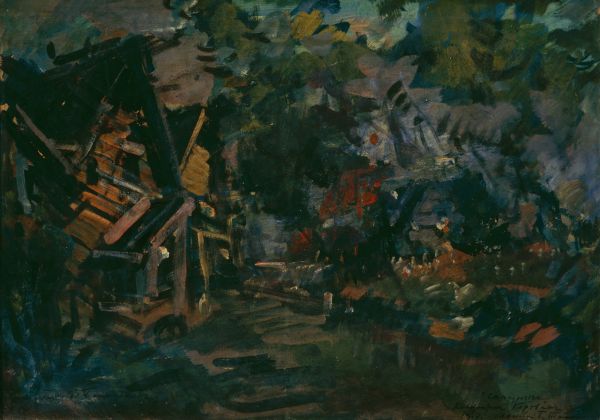|
|
The Land of the Berendeyans. 1914

Korovin Konstantin,
Oil on cardboard
51,5 x 70
State Russian Museum
Annotation
In 1900 Konstantin Korovin became an artist of the Imperial Theatres — the Mariinsky and Alexandrinsky in St. Petersburg and Bolshoi and Maly in Moscow. With Korovin’s arrival at the “official” theatres, artist had become equal co-creator with director, forming through visual means the mood of individual scenes and the emotional environment of the production as a whole. His costume and set designs invariably combine subtle taste,
musicality, precise characterisation and strikingness They stand on their own as a testament to their creator’s rich imagination and magical gift of envisioning the scenic whole. These designs were influential in the evolution of Russian theatrical painting, leading to an awareness of its independent esthetic value. Korovin’s stage designs comprised an era in Russian theatre art. He was especially inspired by operas on fairy-tale and historical themes.
Author's Biography
Korovin Konstantin
Korovin, Konstantin Alexeyevich (1861, Moscow - 1939, Paris)
Painter, theatrical designer, teacher. Studied under Vasily Perov, Alexei Savrasov and Vasily Polenov at the Moscow School of Painting, Sculpture and Architecture (1875-1886) and at the Imperial Academy of Arts (1882). Academician of painting (1905). Member of the Abramtsevo Сircle (from 1885). Member of the World of Art (1900) and founding member of the Union of Russian Artists (1903). Contributed to exhibitions (from 1878). Contributed to the periodical exhibitions of the Moscow Society of Lovers of the Arts (1888-1897) and the exhibitions of the Society of Travelling Art Exhibitions (1889-1899), Moscow Fellowship of Artists (1894-1902), Exhibition of Russian and Finnish Artists (1898), World of Art (1899-1906, 1921, 1922), 36 Artists (1901, 1902), Union of Russian Artists (1903-1923), World Exhibitions in Chicago (1893) and Paris (1900, two gold medals) and the International Exhibitions in Munich (1898), Vienna (1902), Venice (1907) and Rome (1911). Designed for theatres in Moscow and St Petersburg (from 1885). Taught at the Moscow School of Painting, Sculpture and Architecture (1901-1918), State Free Art Studios (1918-1919) and the Stroganov School (1900s-1910s). Emigrated (1922).

